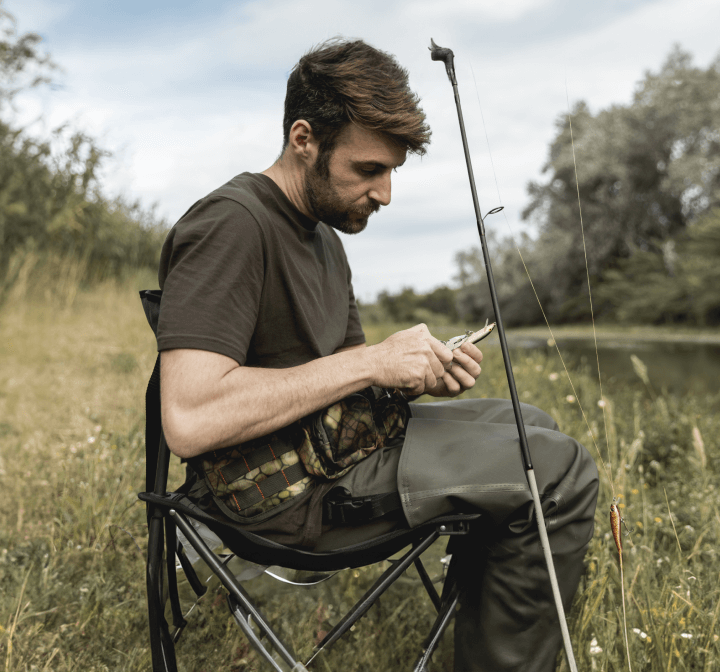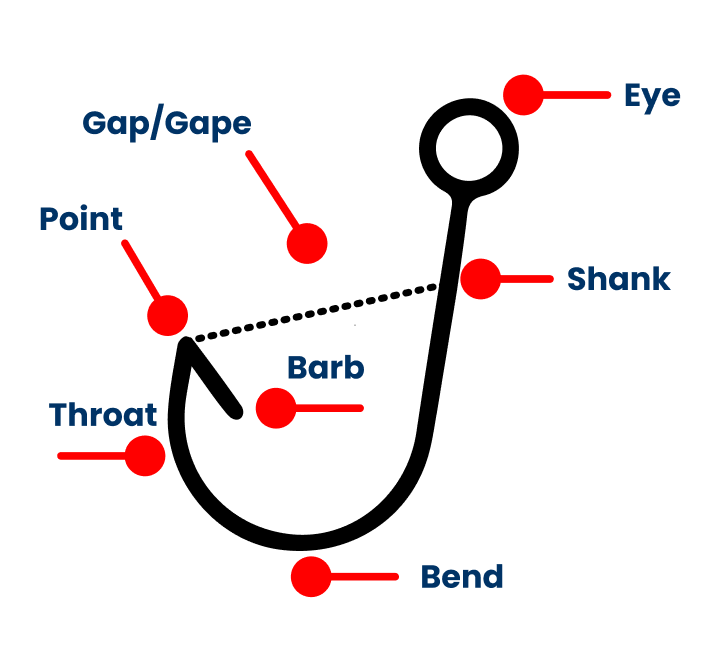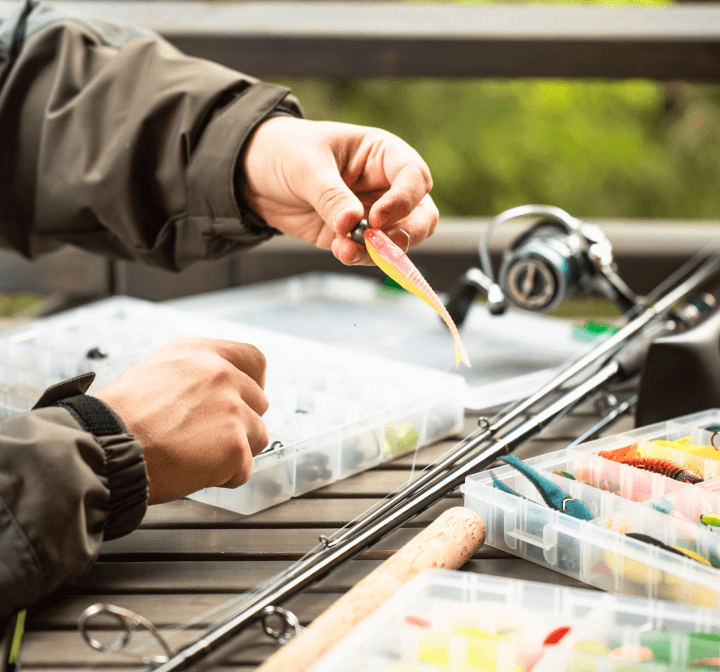The Ultimate Guide to Fishing Hook Sizing and Types

If you’re feeling a little overwhelmed in the fishing hook aisle, you’re not alone. Choosing the right fishing hook size and type can be tricky, even for the most experienced anglers. So grab your tackle box, put on your lucky hat, and let's dive into everything you need to know about fishing hooks to reel in a big one (or at least tell a great story about the one that got away).
Key Takeaways
- What Are the Different Fishing Hook Sizes? — Fishing hooks range from size #32 (smallest) to 27/0 (largest).
- How Fishing Hook Sizes Work: Size (#) vs Aught (/) — Fishing hooks are sized in numbers (#) and aughts (x/0). As numbers decrease, hooks get larger. As aughts increase, so does hook size. Keep in mind that saltwater hooks are larger than freshwater hooks.
- Fishing Hook Size Chart — Choose your fishing hook size based on the fish species you’re targeting and your fishing activity.
- Types of Fishing Hooks — The most common types of fishing hooks are J-hooks, circle, aberdeen, treble, double, single, weedless, siwash, worm, octopus, carp, spoon, fly, and wire leader.
- How To Maintain Fishing Hooks — Keep your hooks dry, clean, and organized. Sharpen all sides of the point as they dull and replace any rusted or deformed hooks.
What Are the Different Fishing Hook Sizes?
Understanding fishing hook sizes can be the difference between a triumphant catch and a fishy escape. They range from size #32 up to 27/0, so you have plenty of options to choose from. However, fishing hooks aren’t one-size-fits-all; what works for a minnow likely won’t work for a marlin.

Looking for something specific? Check out these sections:
- Freshwater vs Saltwater Fishing Hook Sizes — Saltwater hooks are larger and stronger than freshwater hooks.
- How to Choose the Right Fishing Hook Size — Use smaller hooks for smaller fish and larger hooks for larger fish.
- Why Fishing Hook Size and Type Matter — The fishing hook size and type you use impact what type of fish you can catch.
- Understand a Fishing Hook’s Anatomy — Fishing hooks have seven parts: the eye, gap, throat, shank, bend, point, and barb.
How Fishing Hook Sizes Work: Size (#) vs Aught (/)

What tends to confuse anglers the most about fishing hook sizes is that they involve both numbers (written as ‘#’) and ‘aughts’ (written as ‘x/0’). The size system starts with the smallest hooks, size 32, and gets larger as the number decreases. For example, a #10 hook is bigger than a #20 hook.
Once you reach #1, the next size up is 1/0, pronounced ‘one aught.’ From there, the hooks get larger as the aught numbers increase. This means a 2/0 hook is larger than a 1/0 hook.
To simplify it, break the size system into two parts: one part for small to medium hooks (sizes #32 to #1) and another part for larger hooks (sizes 1/0 and up). This dual system can be tricky at first, but once you get the hang of it, it becomes second nature.
Freshwater vs Saltwater Fishing Hook Sizes
The fish hook sizing system is the same for freshwater and saltwater hooks. However, saltwater hooks are larger and stronger than freshwater hooks to withstand harsher environments and heartier fish. This means that a 2/0 saltwater hook is physically bigger than a 2/0 freshwater hook.
Most Common Freshwater Fishing Hooks
- Aberdeen, size 6-10
- Worm Hooks, size 3-5
- Single hooks, size 8-2
- Circle Hooks, 2-1/0
Most Common Saltwater Fishing Hooks
- Circle hooks, 1/0-10/0
- J-Hooks, 1/0-6/0
- Treble hooks, 4-1/0
- Octopus, 2-4/0
- Siwash, 2/0-6/0
How to Choose the Right Fishing Hook Size
To choose the right size fishing hook, there are a few terms you need to know. For all three, the higher the number is, the larger the hook is. We’ll go into more detail about fishing hook anatomy later on, but these basics will help you get started.
- Gauge: This is the thickness of the hook. They can be fine, heavy, or extra-thick. It’s written as ‘2X.’
- Length: This is how long a hook’s shank is. It’s usually written as ‘2X Long.’
- Gap/Gape: This is the distance between the point and the shank of the hook. It’s written as ‘2X Wide.’
When choosing your fishing hook size, the general rule of thumb is to consider the size of the fish you hope to catch. Use smaller gauges, lengths, and gapes for small fish, medium ones for medium fish, and larger ones for large fish.
Fishing Hook Size Chart
The fishing hook size you choose should largely depend on the fish species you’re targeting and your fishing style. Use our fishing hook size chart (it’s printable!) to help you improve your chances of landing that perfect catch.
| Fishing Hook Size Chart | |||
|---|---|---|---|
| Fish Species | Fishing Activity | Hook Type | Hook Size |
|
Albacore |
Trolling, jigging |
Circle Hook |
3/0 - 6/0 |
|
Alewife |
Light tackle, float fishing |
J-Hook |
10 -14 |
|
American Shad |
Spinning, jigging |
Spoon Hook |
4 - 8 |
|
Arctic Char |
Fly fishing, spinning |
Single Hook |
8 - 12 |
|
Arctic Grayling |
Fly Fishing |
Fly Hook |
10 - 16 |
|
Atlantic Angelfish |
Reef fishing |
J-Hook |
6 - 10 |
|
Atlantic Bonito |
Trolling, jigging |
Treble Hook |
4/0 - 6/0 |
|
Bass (Smallmouth) |
Live bait or small soft plastics |
Worm Hook |
2/0 - 3/0 |
|
Bass (Largemouth) |
Live bait or large soft plastics |
Worm Hook |
3/0 - 5/0 |
|
Bluefish |
Casting, trolling |
Wire Leader Hook |
1/0 - 4/0 |
|
Bluegill |
Light tackle, float fishing |
Aberdeen Hook |
8 - 12 |
|
Bowfin |
Freshwater bait fishing |
Circle Hook |
2/0 - 4/0 |
|
Carp |
Carp fishing with bait |
Carp Hook |
2 - 10 |
|
Catfish |
Bottom fishing, bait fishing |
Circle Hook |
5/0 - 8/0 |
|
Cod |
Bottom fishing, jigging |
Circle Hook |
4/0 - 6/0 |
|
Flounder |
Bottom fishing, jigging |
J-Hook |
1/0 - 3/0 |
|
Gar |
Freshwater bait fishing |
Treble Hook |
3/0 - 5/0 |
|
Grouper |
Bottom fishing |
Circle Hook |
8/0 - 12/0 |
|
Halibut |
Deep sea fishing |
Circle Hook |
8/0 - 16/0 |
|
Herring |
Light tackle, float fishing |
Aberdeen Hook |
12 - 16 |
|
Kingfish |
Trolling, live bait fishing |
Treble Hook |
2/0 - 4/0 |
|
Mackerel |
Trolling, live bait fishing |
Treble Hook |
1/0 - 4/0 |
|
Mahi-Mahi |
Trolling with live bait |
Octopus Hook |
7/0 - 9/0 |
|
Panfish |
Live bait, float fishing |
Aberdeen Hook |
6 - 12 |
|
Perch |
Light tackle, float fishing |
Aberdeen Hook |
6 - 10 |
|
Pike |
Lure fishing |
Treble Hook |
2/0 - 5/0 |
|
Pompano |
Surf fishing, float fishing |
J-Hook |
2 - 4 |
|
Salmon |
Trolling, spinning |
Siwash Hook |
2/0 - 4/0 |
|
Skate |
Bottom fishing |
Circle Hook |
4/0 - 6/0 |
|
Snapper |
Bottom fishing |
Circle Hook |
2/0 - 5/0 |
|
Spadefish |
Light tackle, reef fishing |
Circle Hook |
1 - 4/0 |
|
Sturgeon |
Bottom fishing |
Single Hook |
6/0 - 10/0 |
|
Sunfish |
Light tackle, float fishing |
Aberdeen |
8 - 12 |
|
Tarpon |
Saltwater live bait fishing |
Circle Hook |
3/0 - 7/0 |
|
Tilefish |
Deep drop fishing |
Circle Hook |
5/0 - 8/0 |
|
Trout |
Fly fishing, spinning |
Single Hook |
10 -14 |
|
Tuna |
Offshore trolling |
Circle Hook |
7/0 - 10/0 |
|
Walleye |
Jigging, live bait fishing |
J-Hook |
4 - 1/0 |
|
Whitefish |
Light tackle, jigging |
J-Hook |
6 - 10 |
|
Yellowtail |
Jigging, live bait fishing |
J-Hook |
2/0 - 4/0 |
|
Redfish |
Live bait fishing, soft plastics |
Circle Hook |
1/0 - 3/0 |
Common Types of Fishing Hooks

Once you’ve figured out fishing hook sizes, it’s time to educate yourself on the types of fishing hooks. Choosing the right hook type can be confusing because there are so many varieties available — each with its own purpose. Let’s delve into some of the most common fishing hook types.
| Fishing Hook Types | ||
|---|---|---|
| Hook Type | Use | Average Sizes |
|
J-Hook |
General purpose; used with live bait and lures |
1 - 10 |
|
Circle Hook |
Catch and release |
1 - 10/0 |
|
Treble Hook |
Used on lures to increase chances of a catch |
1 - 14 |
|
Double Hook |
Similar to treble hooks but with two points; used for larger baits |
Sizes vary |
|
Weedless Hook |
Used in areas with heavy cover; has a guard to prevent snagging |
1 - 5/0 |
|
Aberdeen Hook |
Light wire hook for live bait; less likely to kill the bait |
6 - 2/0 |
|
Siwash Hook |
Often used on spoons and spinners; has a longer shank and open eye |
1 - 6/0 |
|
Worm Hook |
Used with soft plastic bait |
1 - 6/0 |
|
Octopus Hook |
Used for live bait or as a stinger hook on lures |
10 - 1/0 |
|
Carp Hook |
Designed with a specific bend and point to hold carp better |
2 - 10 |
|
Spoon Hook |
Often used with spoon lures; designed to mimic injured fish |
2 - 8 |
|
Single Hook |
Commonly used for bait fishing; less harmful for catch-and-release |
8 - 4/0 |
|
Fly Hook |
Designed specifically for fly fishing; varies widely based on the fly pattern |
24 - 2 |
|
Wire Leader Hook |
Used for toothy fish; has a wire leader to prevent line cutting |
1/0 - 10/0 |
Types of Hook Eyes
A fishing hook eye is the loop through which the fishing line is threaded). It changes how you secure your hook in your fishing setup. The eye you choose depends on your fishing method and preferences.
- Ringed Eye: This eye is an open loop. It is the most common eye and is used widely across freshwater and saltwater fishing.
- Brazed Eye: This eye is a closed loop. It is typically used in saltwater and big game fishing.
- Looped Eye: This eye is an open, elongated loop. It is used for fly fishing and with some specialized bait hooks.
- Needle Eye: This eye is narrow and elongated like the eye of a sewing needle. It is commonly used for fly tying.
- Tapered Eye: This eye is similar to a ring eye, but it gradually narrows at the loop opening. It is typically used in fly fishing.

Types of Hook Points
The point of a fishing hook is the sharp end that fish bite. The point you use affects how securely the fish is hooked. There are five types of points:
- Needle Point: This point is straight, very sharp, and designed to pierce fish mouths easily. It is ideal for species with softer mouths.
- Spear Point: This point tapers smoothly to a straight tip. It's a good all-around hook point that works well in most fishing scenarios.
- Hollow Point: This point is concave to create a hollow, scooped-out area just behind the tip. It is best for fish with tougher mouths and is most often used in saltwater and big-game fishing.
- Knife Edge Point: This point has a flat, angled cutting surface on one or both sides. It is ideal for targeting species with tough, bony mouths and aggressive behaviors.
- Rolled In Point: This point is slightly curved or rolled inward toward the shank. It is great for species that are prone to shaking off hooks.

Barbless vs Barbed Fishing Hooks
Barbed fishing hooks have small protrusions on the shank near the point that keep the hook securely embedded in the fish, reducing the likelihood of the fish escaping. They’re best for targeting larger, more active species. However, barbed hooks can cause extra damage to the fish.
Barbless fishing hooks don’t have protrusions, making them easier to remove and causing less harm to the fish. They’re best for catch-and-release fishing.
Why Fishing Hook Size and Type Matter
The type and size of fishing hook you use directly impacts the type of fish you can catch and how effective your fishing will be. Different hook sizes are designed to catch fish of various sizes; using a hook that's too large can deter smaller fish, while a hook that's too small might fail to catch larger fish.
Fishing hook size and type are also important because different types of hooks are used for different activities. Circle hooks, for example, are used for catch-and-release fishing to prevent causing unnecessary harm, while fly hooks are made specifically for fly fishing.
Anatomy of a Fishing Hook
An average fishing hook can be broken into seven parts. The exact size and shape of each part varies by fishing activity.

- Eye: A round hole at the top of the shank through which the fishing line is threaded.
- Shank: The long side of the hook that connects the eye to the bend. Shanks can be straight (inline) or curved (offset).
- Bend: The rounded part of the hook that connects the shank to the point.
- Point: The sharp end of the hook.
- Barb: A small, backward-facing piece that prevents the hook from backing out.
- Gap/Gape: The space between the point and the shank.
- Throat: The straight section between the bend and the point.
How to Maintain Fishing Hooks
Let’s be honest: fishing can be an expensive hobby, especially if you have to replace your gear all the time. Here are some tips for making your hooks last longer:
- Use tackle boxes for organization
- Put magnetic strips in your tackle box to keep hooks organized and in place
- Label tackle box compartments by hook size, type, or species
- Use hook guards or bonnets to keep points sharp and prevent them from snagging on other gear
- Always rinse with freshwater after use
- Dry hooks completely before storing them
How to Sharpen a Fishing Hook
If your favorite fishing hook isn’t as effective as it used to be, it might be time to sharpen it. Luckily, you can sharpen hooks in three easy steps:
- Stabilize the hook with your hand or a clamp.
- Using a hook file, whetstone, or diamond hone, start filing from the inside curve of the hook point towards the tip. Do not file back and forth; always move the file in one direction, towards the hook point. Keep the sharpening tool at a slight angle to the hook’s point. Use light, even strokes.
- Repeat on all sides of the point.

Signs You Should Replace Your Fishing Hook
Unfortunately, despite our best efforts, not every hook can be saved. Here are some signs it’s time to retire that old, worn-out fishing hook:
- The hook is dull, and sharpening doesn’t improve it
- Corrosion or rust
- Bent or deformed parts
- Damaged point or barb
- Worn protective coating
When throwing out damaged fish hooks, make sure they are in sealed, puncture-proof containers to prevent accidental harm. You can also check to see if your local fishing retailer has a hook disposal program.
Have Fun Out There!
Now that you’ve mastered fishing hook sizes and types, you’re well on your way to becoming a fishing legend. Remember, the best stories always start with a great hook. If you’re ready to gear up for your next day on the water, check out the wide selection of fishing hooks available at Academy Sports + Outdoors!


